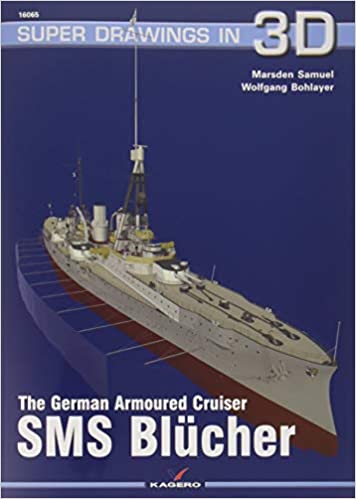Reviewed by CAPT Richard Dick, USN (Ret.)
The German Armoured Cruiser SMS Blücher is a 2018 offering in the Kagero Publishing series, “Super Drawings in 3D.” It truly lives up to the series title. It is a collection of breathtaking color 3D renderings of the Blücher, commissioned in 1909 and sunk at the Battle of Dogger Bank in January 1915. The short book includes representations from above, both sides, bow, and stern of the ship as built, as well as exquisitely detailed renditions of the starboard side from bow to stern. The illustrator then narrows his focus to individual positions and areas of the ship, including the foredeck, steering position, conning tower, boat deck and many others. Following the exterior views, the book uses cutaways and interior drawings to show gun positions, framing, details of steering gear and engineering spaces, etc. The authors take pains to provide technical illustrations of the operation of the shell and cartridge handling and loading machinery, as well as the torpedo tubes and torpedo stowage. Also included is a detailed 1:350 scale drawing of the ship overall and in cross sections.
While the illustrations take pride of place, the brief text reflects the same attention to detail and depth of research. The author lists the ship’s commanding officers from commissioning to loss and presents a brief operational history as well as a reasonable assessment of the effectiveness of the ship’s design.
Blücher, the only ship in her class, was the last and arguably the best armored cruiser Germany built. The design built on the success of the Scharnhorst-class by incorporating more powerful 8.2 inch guns in an all-turret layout on a larger hull capable of 25 knots. The Imperial Navy planned the new design to be an effective counter to what it believed would be the 9.2 inch guns of the new British Invincible-class battle cruisers. When Invincible appeared in 1907 with 12 inch guns, it was clear that the armored cruiser design was an inadequate response and Germany began building the von der Tann battle cruiser.
Nonetheless, once war came, Blücher was assigned to the First Scouting Group of the High Seas Fleet. Her sisters in the group were all battle cruisers armed with 11 inch guns. Critically, by the time of the Battle of Dogger Bank, Blücher was capable of only 23 knots, compared to the 25 knots or more of her companions. When in the course of the battle the British battle cruisers began pursuing the First Scouting Group, Blücher as the last and slowest ship in the German column attracted more British shells than the rest of the group, in part due to tactical and signaling errors on the part of the British. After three hours of legendary resistance to overwhelming firepower, Blücher capsized and sank in the early afternoon of 24 January, 1915.
This volume will be an invaluable resource to modelers and warship enthusiasts. The illustrations are superb. The text, though brief, is generally well done, although a little stiff in translation. Ordinarily a book of this sort would benefit from some indication in the illustrations of where the ship had been hit during various battles. While the author does this for the damage sustained during the raid on Hartlepool in December 1914, it is plainly impracticable for Dogger Bank since Blücher sustained over 70 large caliber shell and multiple torpedo hits. Readers would also benefit from a list of sources and references.
Marsden Samuel is a well-known computer-aided design (CAD) expert who has coauthored other volumes in the Kagero series (SMS Posen, SMS Derfflinger) and illustrated German Battlecruisers of World War One: Their Design, Construction and Operations from the U.S. Naval Institute. Wolfgang Bohlayer is a retired senior manager at Blohm and Voss shipyard, which built many of the German warships that fought in the World Wars.
Captain Dick is a retired submariner and also served for over 29 years in the defense intelligence community.
The German Armoured Cruiser SMS Blücher (Marsden Samuel and Wolfgang Bohlayer, Pen & Sword, Havertown, PA, 2021).


